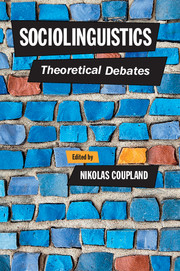Book contents
- Frontmatter
- Contents
- List of contributors
- Preface and acknowledgements
- 1 Introduction: Sociolinguistic theory and the practice of sociolinguistics
- Part I Theorising social meaning
- Part II Language, markets and materiality
- Part III Sociolinguistics, place and mobility
- 9 Mobile times, mobile terms: The trans-super-poly-metro movement
- 10 Sedentarism and nomadism in the sociolinguistics of dialect
- 11 From mobility to complexity in sociolinguistic theory and method
- Part IV Power, mediation and critical sociolinguistics
- Part V Sociolinguistics, contexts and impact
- Part VI The evolution of sociolinguistic theory
- Index
- References
9 - Mobile times, mobile terms: The trans-super-poly-metro movement
from Part III - Sociolinguistics, place and mobility
Published online by Cambridge University Press: 05 June 2016
- Frontmatter
- Contents
- List of contributors
- Preface and acknowledgements
- 1 Introduction: Sociolinguistic theory and the practice of sociolinguistics
- Part I Theorising social meaning
- Part II Language, markets and materiality
- Part III Sociolinguistics, place and mobility
- 9 Mobile times, mobile terms: The trans-super-poly-metro movement
- 10 Sedentarism and nomadism in the sociolinguistics of dialect
- 11 From mobility to complexity in sociolinguistic theory and method
- Part IV Power, mediation and critical sociolinguistics
- Part V Sociolinguistics, contexts and impact
- Part VI The evolution of sociolinguistic theory
- Index
- References
Summary
It is evident that something has been going on recently in sociolinguistics with a sudden upsurge – to the pleasure of some and the chagrin of others – of new terminology. Alongside superdiversity (Vertovec 2007; Blommaert 2010) as a new term to address the intensification of diversity, we now have translanguaging (Garcia 2009a; Blackledge and Creese 2010; Li Wei 2011) and translingual practice (Canagarajah 2013), transglossia (García 2013, 2014; Sultana et al. 2015), polylingual languaging (Jørgensen 2008a,b; Møller 2008), and metrolingualism (Otsuji and Pennycook 2010; 2014), amongst others. According to Blommaert (2013; see also this volume, Chapter 11) the old “Fishmanian” framing of sociolinguistics has been profoundly questioned with this proliferation of new terms signalling “an epistemological rupture with past approaches” (p. 621). All share a desire to move away from the language of bi- or multilingualism, castigating earlier work for operating with the idea that multilingualism is the sum of several, separate languages.
The first aim of this chapter is to provide an overview of these different frameworks, weighing up the different approaches and discussing their similarities and differences. All focus on contexts of multiple, mixed language use (while also trying to escape these notions of multiplicity and mixing) with an interest in talking in terms of repertoires of linguistic resources rather than bilingualism, code-mixing, or code-switching. While there are some differences between these different approaches, they have much in common. Their irruption into the world of sociolinguistics raises at least two questions: To what extent do these new terminologies reflect a changing sociolinguistic world marked by greater diversity, mobility, and language contact (as the notion of superdiversity suggests), or to what extent is this rather a shift in theory that could apply to all eras of sociolinguistic interaction? Does this signal a major paradigm shift in the way we think about languages, or is this rather a case of old wine in new bottles or, worse still, merely a case of “uncouth neologisms and dysfluent phrasings” that “don't represent an advance” (Edwards 2012: 37)? The chapter concludes by evaluating these arguments about whether there is anything new or worthwhile going on here.
- Type
- Chapter
- Information
- SociolinguisticsTheoretical Debates, pp. 201 - 216Publisher: Cambridge University PressPrint publication year: 2016
References
- 57
- Cited by



